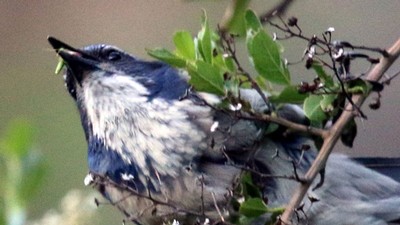We're Resilient: Hansen Life Sciences Retreat Marks 10th Year with Online Event
By Mary-Ann Muffoletto |
Clockwise from top left, Aggie scientists Matt Yim, Hannah Domgaard, Maura Hagan and Monica Borghi were among participants in the 2020 Hansen Life Sciences Retreat Sept. 18-19. The annual gathering honors the late USU biochemist R. Gaurth Hansen.
While planning the 10th annual Hansen Life Sciences Retreat, Lance Seefeldt, head of Utah State University’s Department of Chemistry and Biochemistry, envisioned gathering at a picturesque Cache Valley location and hosting a festive luncheon during the Sept. 18-19 research conference.
“As you know, circumstances changed abruptly, so we quickly pivoted to an online retreat,” Seefeldt says. “We’re resilient. We’re good at that.”
Participants in the event, which provides a forum of discussion for students, faculty and staff from across the university pursuing study of molecular life sciences, agree.
“Being a part of the 10th annual retreat was so cool,” says presenter Koleton Hardy, a biochemistry graduate student. “I’m glad we found a way to make it happen during the pandemic. As far as a virtual versus in-person retreat, I enjoyed being able to see all of the presentations and not having to fight a crowd or strain to hear presenters.”
Rather than a room filled with research posters, the 2020 virtual retreat featured presentations and discussions over Zoom, along with a library of research abstracts and video presentations on the university’s Canvas Catalog course publishing and instructional software system.
Thirty undergraduate, graduate and postdoctoral researchers presented their research abstracts and engaged with conference participants in lively “lightning round” question-and-answer discussions.
“The Zoom chat function really lit up during our discussions,” Seefeldt says. “It was fun to see everyone engaged and asking questions across diverse disciplines.”
Biology master’s student Sage Frehner says questions posed during the discussion were “challenging,” but “that just made it all the more rewarding.”
“It was a wonderful experience to learn how to present and discuss our research,” she says. “It was nice to be able to engage with both faculty and other students with such a broad range of knowledge and expertise.”
Frehner and Hardy were among four student researchers who received presentation awards during the retreat, which drew more than 65 participants from multiple USU departments.
Arianna Towne, who conducts research with faculty mentor Joanie Hevel, associate professor in the Department of Chemistry and Biochemistry, received the Undergraduate Presentation Award. Towne presented, “Investigating the Impact of the Primary Amino Acid Sequence of C. elegans PRMT1 on Enzyme Activity and Thermostability.”
Graduate Student Presentation Awards went to Frehner, Hardy and Hayden Kallas.
Frehner, who conducts research with faculty mentor Sara Freeman, assistant professor in the Department of Biology, presented, “mRNA Distribution of Oxytocin and Vassopressin-1a Receptors in the Neurotypical Postmortem Human Brain.”
Hardy presented “Exploring Regulation through Post-translational Phosphorylation in the Shigella Type-III Secretion ATPase Spa47." He pursues research with faculty mentor Nick Dickenson, associate professor in the Department of Chemistry and Biochemistry.
A biochemistry doctoral candidate, Kallas presented "Investigations into N2 Inhibition in Nitrogenase." Seefeldt is his faculty mentor.
In addition to student presentations, three new faculty members, all assistant professors in the Department of Biology, introduced their research through laboratory overviews.
Monica Borghi, joining the retreat from Europe, discussed her work in flower metabolomics. Norah Saarman shared her research, which integrates population genomics, landscape modelling and functional genomics to predict population responses to climate change. Molly Womack discussed her research spanning macroevolution, development, morphology and sensory ecology.
Keynote speaker was Dana Carroll, Distinguished Professor of Biochemistry at the University of Utah School of Medicine. Over Zoom, Carroll presented “Genome Editing: A View from the Edge,” during which he discussed his pioneering research with programmable nucleases.
“Cindy Weatbrook, our graduate program and technology coordinator, did an excellent job of designing the virtual retreat and organizing the presentation material,” Seefeldt says. “Our office manager Erin Russell also oversaw the transition from an in-person to virtual event, handling registrations and coordinating our researchers’ participation. They were key to the success of this event.”
The gathering honors the memory of renowned biochemist R. Gaurth Hansen (1920-2002), a gifted scientist, teacher and administrator, who spent much of his career enriching Utah State. A Cache Valley, Utah native, Hansen joined USU's faculty as an academic vice president in 1968, and was soon promoted to provost. His efforts contributed to a twenty-fold increase in the university's research budget. He was named USU Distinguished Professor Emeritus in 1985 and retired from Utah State in 1994.
The Hansen Retreat is supported by R. Gaurth Hansen’s son and daughter-in-law, Lars Peter Hansen and Grace Tsiang.
Dana Carroll, Distinguished Professor of Biochemistry at the University of Utah School of Medicine was keynote speaker for the 2020 Hansen Life Sciences Retreat. He presenting his pioneering research in genome editing with programmable nucleases.
WRITER
Mary-Ann Muffoletto
Public Relations Specialist
College of Science
435-797-3517
maryann.muffoletto@usu.edu
CONTACT
Lance Seefeldt
Professor and Head
Department of Chemistry and Biochemistry
435-797-1619
lance.seefeldt@usu.edu
TOPICS
COVID-19 157stories Chemistry 110storiesComments and questions regarding this article may be directed to the contact person listed on this page.









